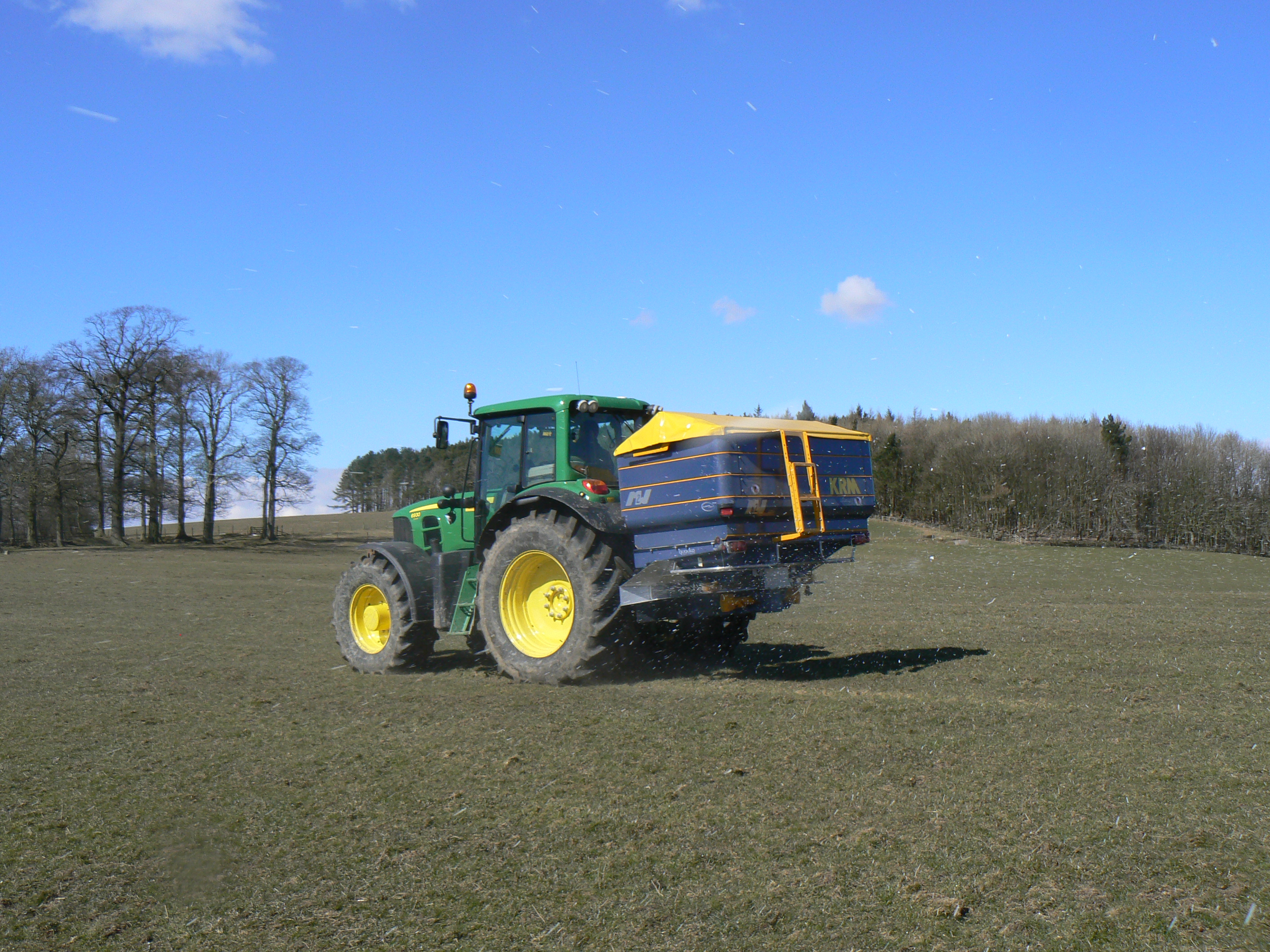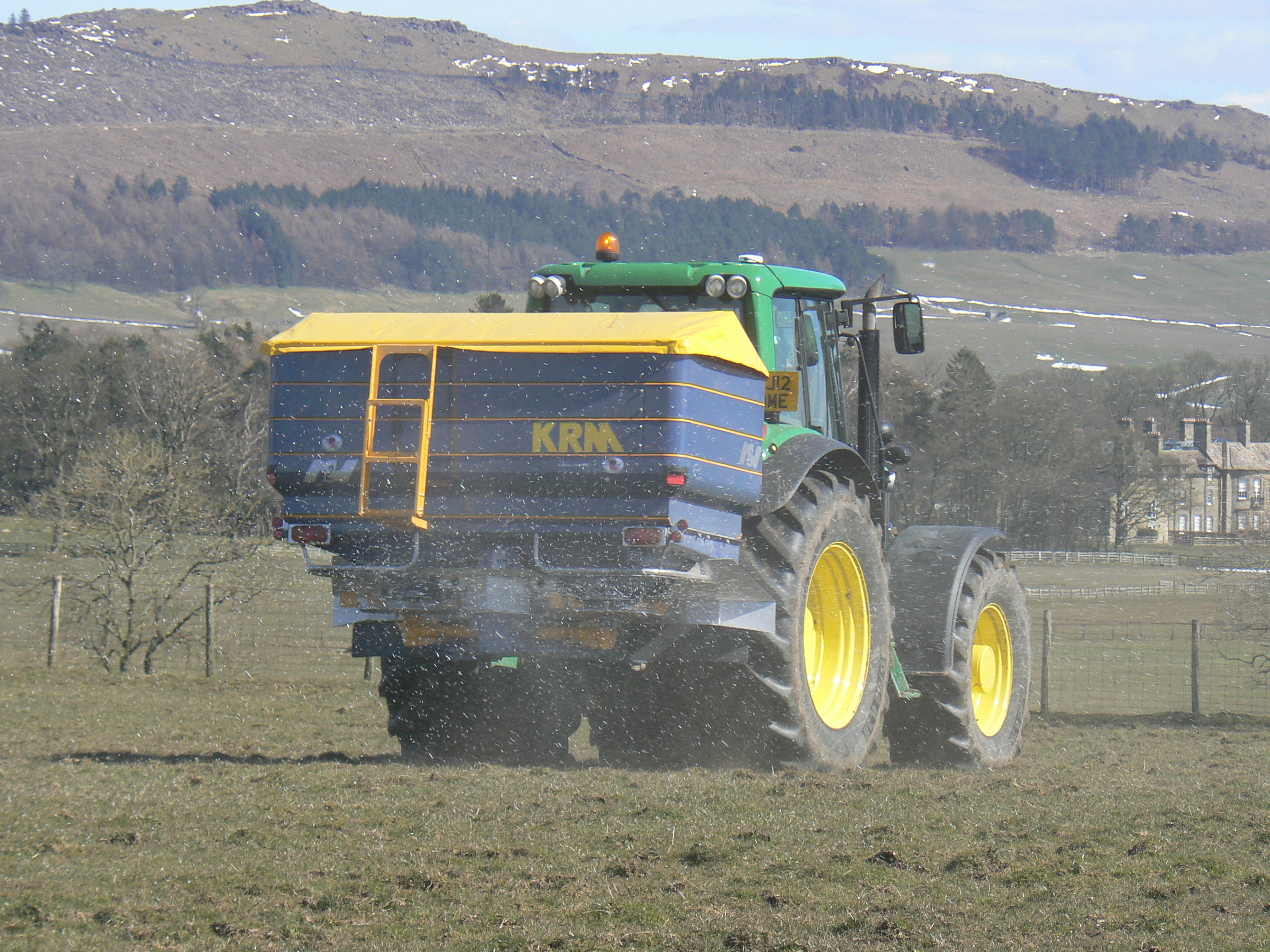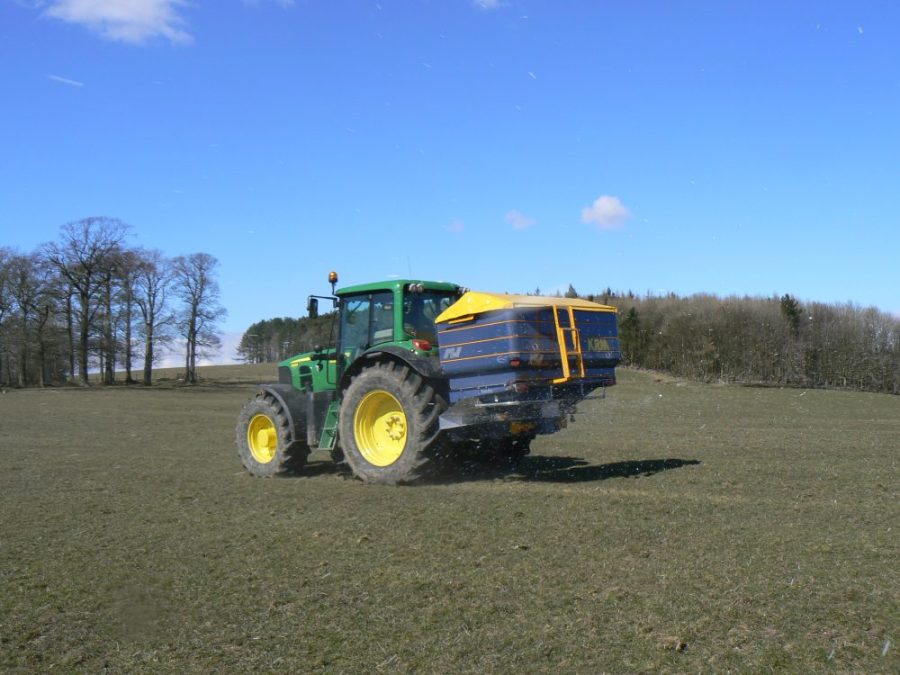
With a wide and diverse business portfolio, and an emphasis on good environmental management, Grosvenor Farms near Chester, has specific needs of its fertiliser spreader. CPM visits to assess what these are.
You can put pretty well anyone onto the job – all they have to do is set the rate.
By David Jones
“In the vanguard of modern farming” were the words used by the committee of the Food & Farming Awards to describe Grosvenor Farms when announcing it as Farm Business of the Year for 2016.
With its base at Aldford Hall Farm, on the Easton Estate, near Chester, Grosvenor Farms is a mixed farming enterprise extending to 2330ha and revolves around the 1800-strong dairy herd, 1100 or so followers and 350 dry cows. The arable side of the business, which accounts for around 90% of the total land area, acts as contractor to the dairy business and aims to provide as near to all of the feed, forage and bedding requirements as can be achieved.
It’s one of the operating companies of the Wheatsheaf Group, which also owns the bovine genetics business, Cogent. The two work closely to maintain and improve herd health, productivity and quality.

Grosvenor Farms has what is believed to be the largest stewardship scheme in the country.
The farm grows wheat, barley, oilseed rape, maize and grass (for silage) on 2100ha – generating 25% of the total income. The dairy side occupies just 10% of the area and contributes the other 75%. Average field sizes are 6.55ha on the arable side, a little over 3ha for the grass. Soils are mainly of the Salop series, with some sandy loam over sandstone.
While a share of the crop production feeds and beds the dairy business, pay-back comes in the form of muck and dirty water. The 15,000t of muck produced by the herd annually represents a large proportion of the farm’s crop nutrient requirements. In addition, most crops receive an application of dirty water, facilitated by the 78,000m3 of the liquid that the business generates. An underground main serves much of the farm.
In addition to the mainstream dairy and arable business, Grosvenor Farms has 13 tenanted farms, a golf course and what is believed to be the largest stewardship scheme in the country. Charlie Steer has been Grosvenor Farms’ arable manager for the past seven years, and it’s this last element – also Charlie’s responsibility – that he takes very seriously.
“We’ve got 72ha of arable reversion land along the banks of the River Dee, wetlands, 6m field margins – which, on average, cover areas that are around 50% less productive anyway – and woodland buffers, all in the Higher Level of the Countryside Stewardship Scheme.
“The arable reversion is an interesting project, as it’s been converted to low input grassland with the aim of improving the water quality in the Dee,” he explains. “It’s a Site of Special Scientific Interest and the aim here is to stabilise the river banks while reducing soil and nutrient run-off.”
A further 80ha has been sown with wildflower mixes with the aim of helping to reverse the decline in species such as grey partridge, skylark, lapwing, yellowhammer, corn bunting, brown hare and bumble bees. Input from Natural England, the Cheshire Wildlife Trust and the Game and Conservation Trust is helping the scheme to flourish.
With an emphasis on responsible environmental management, the choice of fertiliser spreader is a key purchasing decision. One of Charlie’s more recent moves involved replacing the two fertiliser spreaders – a Kuhn Axis and an Amazone ZA-M – with a new KRM M2W. This machine has completed its first season’s work, performing the task across the entire arable area, and while the Kuhn was moved on, the decision was made to retain the Amazone as a back-up.
So why was Charlie drawn to the KRM? “One of the first features that impressed us was just how easy it is to set up,” he states. “You can put pretty well anyone onto the job – all they have to do is set the rate. Although we didn’t use the variable rate facility as a matter of course this year, we did experiment with it in a couple of fields.”
The machine’s headland operation also comes in for praise. “Just by reversing the discs, the back of the vane comes into play which creates a sharp cut-off at the headland,” he reports. Then there’s the build quality and finish: “The paintwork is second to none and there’s plenty of stainless steel.
“The bag lifter option – also made by KRM – is also very good and the section control is fantastic. The degree of accuracy is everything that we could want.” The operators have also welcomed the KRM’s arrival, “even the old boys,” he says. “They get through a lot of work in the course of a day and there’s really very little to do in terms of set-up.”
Charlie believes that, at the end of the day, it all comes down to work rate, what can be achieved and the cost per ha. “One day towards the end of the summer, one guy managed to spread over 240ha on land the other side of the River Dee, with just one other driver ferrying the fertiliser to him. We were applying at a fairly low rate, so he didn’t have to make too many trips.
“When we get a new machine, our operators soon get very proficient at what they do and they look after each piece of kit themselves.
“If I had to sum up our experiences after one season of using the KRM, I’d say it’s already a highly-valued component of a very efficient farming operation.”
Keith Rennie at KRM recalls the lead-up to the purchase. “Grosvenor Farms have been dealing with Agricultural Machinery (Nantwich) since the early 1990s. They’re currently looked after by John Machin, who’s been a salesman at the company for many years.
“Grosvenor run a lot of John Deeres and had, at the time, just purchased – through John – a 5155R tractor that was specified with AutoPower, AutoTrack and the latest Gen 4 Command Centre. It was ISOBUS ready and unlocked for section control variable rate.”
There are actually no less than 14 John Deere machines that provide the tractor power at Aldford Hall: five 6930s, four 6150Rs, two 6210Rs, a 6155R, a 6630 and a 6920. The R Series tractors are fitted with the JD Greenstar control and guidance system. In addition, there are two Case Quadtracs – 440 and 540.
It was in Sept, 2016 that John Machin became aware that Grosvenor, through Charlie, was in the market for a new spreader and arranged for KRM to bring a machine down from the factory in North Yorks. “We discussed the machine and came up with a spec that would suit their needs and John quoted accordingly,” says Keith.
“Roll forward to early spring 2017,” he continues, “and I visited Aldford Hall Farm again with a machine that was to the required specification. I was joined on the day by Geoff Whiteside – the dealership’s AMS specialist – and together we set up the tractor and spreader. We then went into the field to spread some fertiliser and to demonstrate that all the systems were working in harmony.”
The spreader was fitted with the KRM weigh cell system that monitors the machine constantly. “It makes any necessary adjustments to ensure the correct rate is being applied at all times throughout the process,” says Keith.
“It’s also VTR-ready and so can respond to variable rate maps loaded into the tractor – and it features dynamic section control. All this is handled by the John Deere Gen 4 display via ISOBUS.”
Shortly after the machine was delivered, Charlie got in touch with KRM to say that they would also like to proceed with the purchase of the BXL 1300 Big Bag Lifter, which had been an option from the start. “So, I visited again to fit the bag lifter and ensure that all was well with the machine,” Keith reports.
Spreading a difference
The KRM M2W spreader has what the manufacturer calls a ‘double double overlap’ spread pattern when working in-field. Within this system large diameter stainless steel discs rotate towards each other to provide the greatest accuracy of application, says KRM. On the headland, the rotation of the discs is reversed. The rear of the vanes comes into play and this creates a sharp headland cut-off.
Both left and right-hand discs apply the fertiliser across the full spread width to provide an accurate double overlap, tramline to tramline, says KRM. As the machine then spreads the next tramline, another double overlap is applied, so that the area effectively receives four applications in all. KRM refers to this as the little-and-often approach.
The aim of this technique is to minimise the effect of outside influences likely to cause disruption to the spreading procedure – wind, uneven soil surface, variations in materials applied, PTO speed fluctuations, etc. “By using the Double Double overlap system,” Keith Rennie explains, “where, effectively, four applications are being made, any of these external factors will have much less influence than they will with other spreading systems that provide less of an overlap.”
Bogballe imports tailored to UK spec
From its premises at Boroughbridge, North Yorkshire, KRM imports the Bogballe-manufactured spreaders from Denmark – in addition to Bredal muck spreaders – before assembling the machines and preparing them to UK customers’ individual specifications. The fertiliser spreaders are then finished in KRM’s blue and yellow livery prior to farm delivery.
KRM is a long-established business with its origins in the mid-1980s. The original objective was, by dealing with premium rated specialist manufacturers like Bogballe and Bredal, to become aligned with those companies at the forefront of new development. Since then, the input from Keith Rennie and his team to the production process, including their knowledge of UK conditions in particular, has gone a long way in helping to position these brands as household names in their field.
Another market successfully penetrated by KRM is that for seed drills. Imported from Spain and given the KRM treatment, the range includes power harrow and cultivator mounted machines, as well as box drills and trailed models.
Farm Facts
Grosvenor Farms, Aldford Hall Farm, Chester
- Farmed area: 2330ha
- Enterprise mix: Arable (wheat, barley, oilseed rape, maize and grass for silage); 1800 head dairy herd with 1100 followers and 350 dry cows; c150ha in Higher Level Countryside Stewardship
- Soils: Salop series, with some sandy loam over sandstone.
- Mainline tractors: Case Quadtrac 440 and 540; 5x John Deere 6930s, 4x 6150R, 2x 6210R, 6155R, 6630, 6920.
- Spreader: KRM Bogballe M2W Base with 2675-litre hopper




